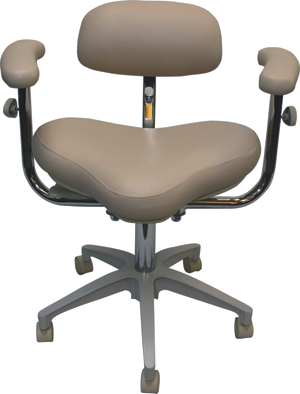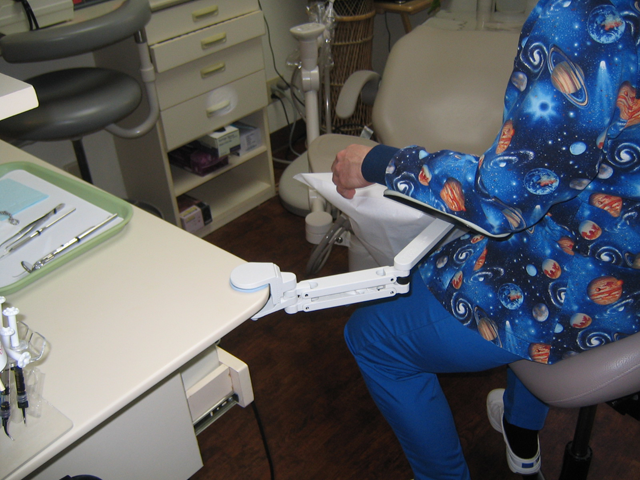Armrests or no armrests?
Exploring the benefits of armrests for dental practitioners.

From an ergonomic standpoint, your operator stool is the most important chair in the treatment room. Patients come and go, but you are there for the duration of the day, so proper and safe positioning of your body should be paramount. Dental stool models claimed to be "ergonomic" run the gamut from backrest with armrests, to backrest without armrests, to armrests without backrests, to no backrest and no armrests.
Fig. 1A

To add to the conundrum, there is a dearth of dental studies regarding the benefits (or lack thereof) of these two features on the health of the dentist. But what is certain from the literature, is that these features definitely have an impact on your health, so they deserve more in-depth evaluation.
Armrests
Studies support the use of armrests in the prevention of neck, shoulder and low-back pain. Armrests have been shown to decrease muscle activity in the neck and shoulders of dentists, especially in the upper trapezius on the handpiece, or dominant side. Elbow rests also reduce activity in the rhomboid, and thoracic and cervical erector spinae muscles. Because tension is held in these muscles for prolonged periods of time in dentistry, lowered tension in these muscle translates to reduced pain.
Trending article: 5 ergonomics tips that could save your career
Fig. 1B

There are several styles of armrests on the market today: adjustable fixed armrests, movable telescoping armrests, elbow supports and ratcheting armrests. Armrests should be highly adjustable to provide support to the operator in a neutral working posture. Different styles tend to be more appropriate for different team members. So which style of armrest is right for you? A very popular and effective style among general dentists is the movable telescoping armrest which moves in/out and forward/backward with the operator and can be set at a specific height and resistance (Fig. 1A). This comes in 2D and 3D models, and is offered by many dental chair manufacturers. I have found that general dentists usually prefer the 2D telescoping armrest over the 3D.
Fig. 1C

Endodontists work in one position for prolonged periods, and may find that adjustable fixed armrests provide the best support. This type of armrest system is highly adjustable in multiple directions: width, height, forward/backward, and in some models, the armrest itself often tilts for optimal hand positioning. Once the desired position is found, the knobs can be tightened to secure the settings (Fig. 1B). A pivoting movable elbow support moves freely with the operator, but some styles are quite large and may require a larger operatory (Fig. 1C). Ratcheting armrests are usually seen on assistant stools, but are available as an option on Crown Seating stools. This allows for a very firm base of support (Fig. 1D).
More from the author: A mysterious upper-back pain syndrome in dental professionals
Proper adjustment of the armrests is essential in preventing neck and shoulder problems. Adjusting the armrests too high can actually worsen neck pain, as it puts the levator scapulae muscle on slack and can cause neck stiffness and pain at the crook of the neck and shoulder. Armrests should be adjusted so there is no palpable tension in the operator’s upper trapezius muscles when resting on them. Proper width adjustment (between armrests) is also important, since armrests set too far apart will cause abduction of your arms. Positioning the armrests too far forward can encourage the dentist to lean forward, compromising operator posture.
Fig. 1D

From an ergonomic standpoint, it is desirable to operate with two armrests, however if you have a confined operatory space and find it difficult to maneuver a chair with armrests around the patient, you may want to consider a unilateral armrest fixed to a counter (Fig. 2). Dentists who operate with the left arm resting have been shown to have less pain than those who do not. These are available in a variety of heights to adjust to multiple users and situations.
Some styles of dental stools without armrests can be retrofitted with armrests. Crown Seating offers a myriad of armrest styles, many of which fit other manufacturers’ stools. You may download a brochure listing five styles of armrest styles at www.crownseating.com/catalog.html
Fig. 2

To be clear, armrests are not an automatic solution for all operators with neck pain. Depending upon the etiology of your pain, taking the arm weight off your neck and shoulders may or may not reduce your symptoms. During in-office consultations, I perform a specific physical therapy test to determine if individuals with neck pain would benefit from armrests. Dentists should always request trialing a stool for one-to-two weeks before purchasing it to evaluate the comfort and benefits of armrests.
Dentists should remember that just because they are not currently experiencing pain, it doesn’t mean there is no structural damage occurring. Armrests should be considered not only as a pain intervention, but also as a prophylactic to ensure a long and healthy career.